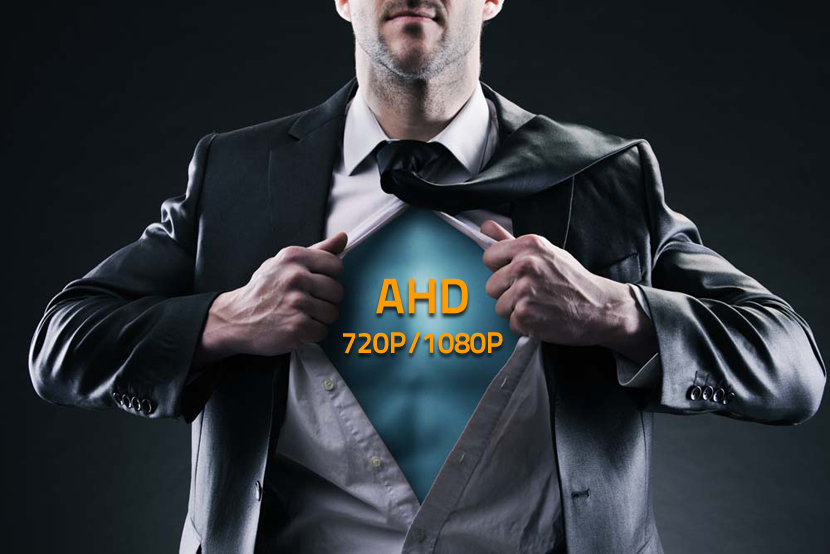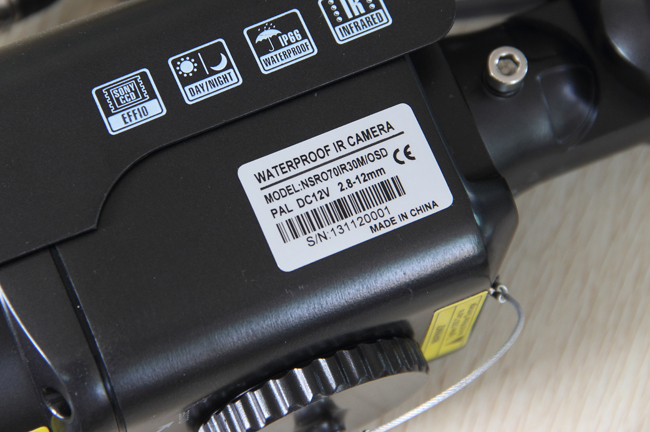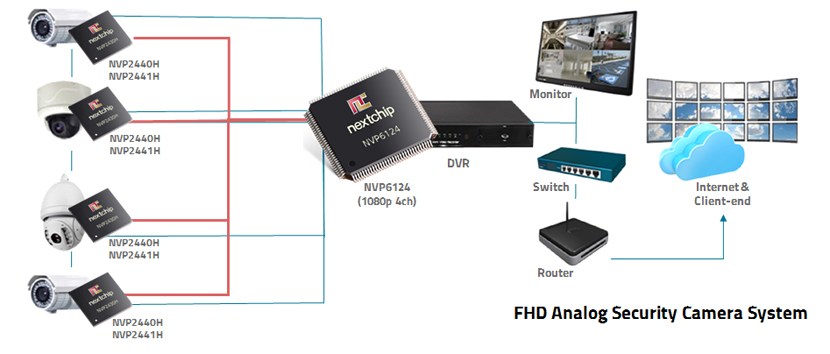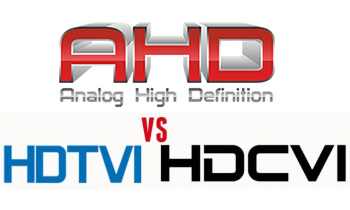
AHD camera: truths and facts you must know
Decide to upgrade your old conventional analog video surveillance system? or plan to buy and install a new "High Definition" analog surveillance system? Well, you may feel headache in front of different HD-over-coaxial technologies including AHD, CVI, and TVI. So one question may come to your mind, "which one is the best among them?". When search online, you will find many articles promote that each of technologies is the ideal choice for your analog video surveillance system. End-users are not the only people encounter this problem, some camera manufacturers even can't decide. In this article, we intend to share you some truths and facts you must know about AHD camera.
We will not introduce you some basic information about the AHD camera, because you can find many such kind of articles online. In the past, we have already written some articles to introduce AHD camera when it firstly launched into market. If you think this article is useful, please bookmark and share this page.
1# Is 720p AHD better than Sony Effio 700TVL?
People are quite familiar with Sony Effio, Effio is used to be the main product in analog video surveillance market. Since the CVI, AHD, TVI products come into play, its glare gradually fades away. According to Nextchip (Korean chipset manufacturer, developer of AHD technology), AHD has three versions: AHD 0.8, AHD 1.0 and AHD 2.0. AHD 1.0 can support 720p high definition (HD) video capturing and recording. AHD 2.0 can support 1080p full high definition (FHD) resolution. Is AHD 720p better than Sony Effio 700TVL? The answer is no, the real test result is AHD 720p is equal to Sony Effio 700TVL.
2# 720p AHD vs 720p IP Camera, which is better?
As a technician in surveillance industry for almost five years. I will recommend IP video surveillance system when customers want to setup a new video surveillance system. It's undeniable that analog HD-over-coaxial technologies are cheaper and able to deliver so-called "720p / 1080p" HD video, but IP camera system is future proof. Unless you want to upgrading existing analog system because coaxial cables are not easy to replace, HD-over-coaxial products can be good choices. So, 720p AHD/CVI/TVI vs 720p IP camera, which is better? The answer is 720p IP camera is better. From end-user's report, the 720p AHD image resolution is poorer than 720p IP camera, but 960P (1.3 megapixel resolution) image quality is equal to 720p images from IP cameras.
In summary:
- 720p AHD/CVI/TVI = Sony Effio 700TVL analog cameras
- 960P AHD/CVI/TVI = 720p (1.0MP) Network cameras
- 1080P AHD/CVI/TVI = 960P - 1080P (1.3MP - 2MP) Network cameras
3# Can AHD cameras connect to traditional monitor?
Analog camera + nextchip TX (transmitter) chipset = AHD camera, this means AHD camera can't connect to traditional monitor. When AHD cameras connect to traditional monitor, the CRT monitor can show image, but it's black/white color. Additionally, the AHD cameras also can't work with Analog Matrix and other video transmission, recording & displaying device. Can AHD cameras work with traditional DVR? Well, it's a bit complex for this question, we answer this may take a paragraph.
4# AHD cameras may work with your 960H DVR
As the above title showed, AHD cameras may work with your 960H DVR. Let me explain:
1. Depending on your AHD cameras: AHD cameras have total three formats; AHD 0.8, AHD 1.0, AHD 2.0. If you choose AHD camera that supports AHD 0.8 format, then camera will deliver 960H resolution, so it works with your traditional 960H DVR. This is the reason why Nextchip claims AHD is back-compatible with conventional analog video surveillance system.
2. Depending on your DVRs: Based on DVR hardware, DVR manufacturers developed ADVR (AHD DVR) fast. The most of ADVR supports different resolutions including CIF, D1, 960H/AHDL, AHDM. This enables DVR to work with both conventional CCTV cameras and AHD cameras.
5# Many AHD cameras claim to deliver 1000TVL, 1200TVL or even 2000TVL resolution, is it true?
In order to obtain much more customers, some security camera manufacturers may use fictitious TV line specification on its products. The actual product image resolution may not reach claimed resolution. 1000TVL, 1200TVL, or ridiculous 2000TVL etc are not true. To clarify this, we should read our test reports of some IP cameras.
- Panasonic WV-SPN631: 2MP IP camera, tested horizontal resolution is 1000TVL
- http://www.unifore.net/product-highlights/panasonic-wv-sfn531-2-4mp-network-camera-test-report.html
- Hikvision DS-2CD4026FWD/D: 2MP IP camera, tested horizontal resolution is 1100TVL
- http://www.unifore.net/product-highlights/hikvision-2-megapixel-low-light-wdr-network-camera-review.html
- KEDACOM IPC185: 4K UHD IP camera, tested horizontal resolution is 2000TVL
- http://www.hkvstar.com/product-news/test-report-review-4k-uhd-network-camera.html
- Hikvision DS-2DE5120I: 1.3MP network PTZ camera, tested resolution is 900TVL
- http://www.hkvstar.com/product-news/1-3mp-ip-ptz-camera-review-hikvision-ds-2de5120i.html
The above test reports are published by ASMAG magazine (only in Chinese), they measured the resolution through using camera resolution testing card. Basically, the tested results are accurate. So, you may get a "2000TVL" AHD camera, but its actual resolution is 960P. This happens when customers are happy to buy the AHD cameras, but they feel being cheated after products are installed. Some AHD cameras even deliver video with image quality poorer than existing 960H products.

6# How to choose ADVR for your AHD cameras?
Although AHD isn't as good as it has been advertised, you may still want to try the AHD products. Firstly, choosing 960P AHD cameras, therefore you won't blame yourself on your courageous attempt. Secondly, you need to choose a right ADVR. To choose a right ADVR, you need to consider the following two things:
1. Recording & Playback resolution
Choosing ADVRs that support higher resolution, or at least match the resolution of your AHD cameras. I personally recommend users to buy 1080p AHD DVRs, since it's the highest recording resolution the DVR supported. According to AHD DVR specification, there are three recording formats:
- AHDL: AHD 0.8, works with 960H AHD cameras and traditional analog cameras
- AHDM: AHD 1.0, works with 960P/720P/960H AHD cameras
- AHDH: AHD 2.0, works with 1080P/960P/720P/960H AHD cameras
2. Frame per second (FPS)
The frame rate means display or record frame per second. For frame rate, when all the DVR in real-time recording, the frame rate is 30 (NTSC) / 25 (PAL) frames per second, for advertising DVR can record more frame rate than 30 frame per second are untrue. To get a good quality analog video surveillance system, you need to use DVRs that provide real time recording.
A small story to share with you: several days ago, one client found our website and chatted with us, he bought a 960H DVR kit, he reported that the included DVR only can support 960H recording at 12 FPS. After realized it was not real-time recording, he decided to return the DVR back to seller. So, one simple tip to you, when purchase DVRs, you should know its recording FPS specification, even though suppliers claim its "real-time'.

7# Comparison among AHD, CVI, TVI
This topic has been discussed since AHD, CVI, TVI come into market. The reason is so simple, in terms of resolution and transmission distance, they are very similar. In stead of comparing among AHD, CVI, TVI, you may want to know the difference among CVI/AHD/TVI, HD-SDI, IP. My previous article, can offer much information on this.
http://www.unifore.net/analog-surveillance/analog-hd-technologies-ahd-hdtvi-hdcvi-cchdtv-hdmdi.html
Compared with CVI, AHD and TVI are open technologies. Keep in mind, they are not compatible each other, never ever. Interoperability is a big problem among these analog technologies. This means if you use AHD cameras, you have to use AHD DVRs. CVI cameras must work with CVI DVRs, TVI cameras must work with TVI cameras. Dahua, Hikvision, Nextchip, they are not willing to cooperate together to solve this.

8# A Real AHD Camera System Review
Because one customer want to upgrade the existing analog system to High Definition system, and coaxial cables are sealed inside the wall, re-cabling is difficult, therefore considered to use HD-over-coaxial solutions. We want to choose between CVI, TVI, AHD.
Since AHD is pretty new technology when compared with other HD-over-coaxial technologies, we firstly tested AHD. We used one set 8CH AHD DVR (supports AHD-M, 960P), with 8 pieces 960P AHD cameras. After we received the package, we conducted testing immediately. 960P image quality is much sharp and vivid. After connected to 200 meter coaxial cable to test, we didn't find images changed, but we still encountered some problems:
1. DVR supports 4 video recording modes: Digital mode( support 8CH 1080P, 960P AHD-M), Analog mode (8CH 720P AHD-L, D1, CIF), 4CH Network 1080P mode, 1CH Network 1080P + 8CH Network 720P. If choosing 960P mode, DVR can't work with existing conventional analog cameras, while if connecting traditional analog cameras, DVR can't support 960P. Consequently, 960P recording only can work standalone, can not co-exist with conventional analog cameras.
We consulted to the distributor whether DVR can support 4CH 960P + 4CH D1 mode, he replied "can not".
2. The current AHD-M DVRs only support maximum 8 channels. But CVI and TVI have 16-32 channel DVRs. The most of our clients are using 16 channel (or more than) DVRs, so these DVRs can not be replaced completely.
Finally, when compare between AHD and CVI, we found that AHD camera image colors are vivid, while CVI camera image colors are subdued. We also tried to connect AHD and CVI together, we found:
- AHD cameras connect to CVI DVR: B/W images, 3-5s images disappear, 1-2s images restore.
- CVI cameras connect to AHD DVR: B/W images, no other problems. Resolution is basically equal CVI camera's resolution.
9# Appendix
AHD Cameras Chipset + Image Sensor
| Format | Chipset (NextChip) | Image Sensor | Effective Pixels |
| AHD 720P/960H | NVP2431H | Sony IMX225 | 1280x720 |
| AHD 720p/960H | NVP2431H | Sony IMX238 | 1280x720 |
| AHD 1080P | NVP2441H | OmniVision OV2710 | 1920x1080 |
| AHD 1080P+960H | NVP2441H | Aptina AR0230 | 1920x1080 |
| AHD 1080P | NVP2441H | Sony IMX222 | 1920x1080 |
| AHD 960P | NVP2431H | PixArt 5130 | 1280x960 |
| AHD 960P | NVP2431H | Aptina AR0130 | 1280x960 |
| AHD 720P | NVP2431H | Aptina AR0141 | 1280x800 |
| AHD 960P | NVP2430H | Sony IMX238 | 1305x1049 |
| AHD 720P | NVP2431H | OmniVision OV9712 | 1280x720 |
Get My Latest Posts
Subscribe to get the latest updates.
Your email address will never be shared with any 3rd party.
Scan me




